Have you ever pondered on how many types of pigeons there are? While your exposure might be limited to the types of pigeons in the park, pigeons are not restricted to those grayish birds!
Pigeons are some of the most widespread, well-known, and disliked types of birds worldwide, but did you know there are more than 300 different types of pigeons?
Aside from the common pigeons, there are also several domestic pigeons with unique colors and features.
Pigeon breeding is a popular pastime. If you’re fascinated by the diversity of nature and are interested in discovering that they are more than just “winged rats,” this article might be just for you!

What Is A Pigeon?
Pigeons are a group of birds that belong to the Columbidae family. Although many of us regard pigeons and doves as different birds (genetically speaking), they are the same thing.
The difference is “etymological” (relating to the origin of words). The word “pigeon” comes from the French, while “dove” is of Nordic origins.
However, many agree that a pigeon denotes a bigger bird, while doves are smaller.
There are roughly 351 different types of pigeons and doves in 5 subfamilies and across 50 genera.
Did you know? Of all the collective nouns for animals, the names for groups of birds are the most interesting ones. A group of pigeons is called a band or a flock of pigeons!
Characteristics And Traits Shared By Pigeons
Although pigeons and doves vary in size, color, and feathers, there are some family-wide characteristics.
These include small, rounded heads and small, slim bills. They usually have short scaly legs.
Pigeons have rounded bodies, long tapered wings, and are covered in dense, soft feathers. Most pigeons have a small fleshy patch at the base of the bill (cere).
Pigeons share some particular behaviors, including cooing or crooning calls, a characteristic “bobbing head” gait, and they “suck” liquids up instead of sipping and swallowing.
Many different types of pigeons produce “pigeon milk,” which they feed their young.
While there are always outliers, most doves and pigeons fit these characteristics.
Pigeons live on every continent except Antarctica. Although they utilize a range of habitats, they avoid extreme cold and desert conditions and inaccessible islands.
Roughly two-thirds of pigeons occur in Australia, Southeast Asia, and the Western Pacific islands.
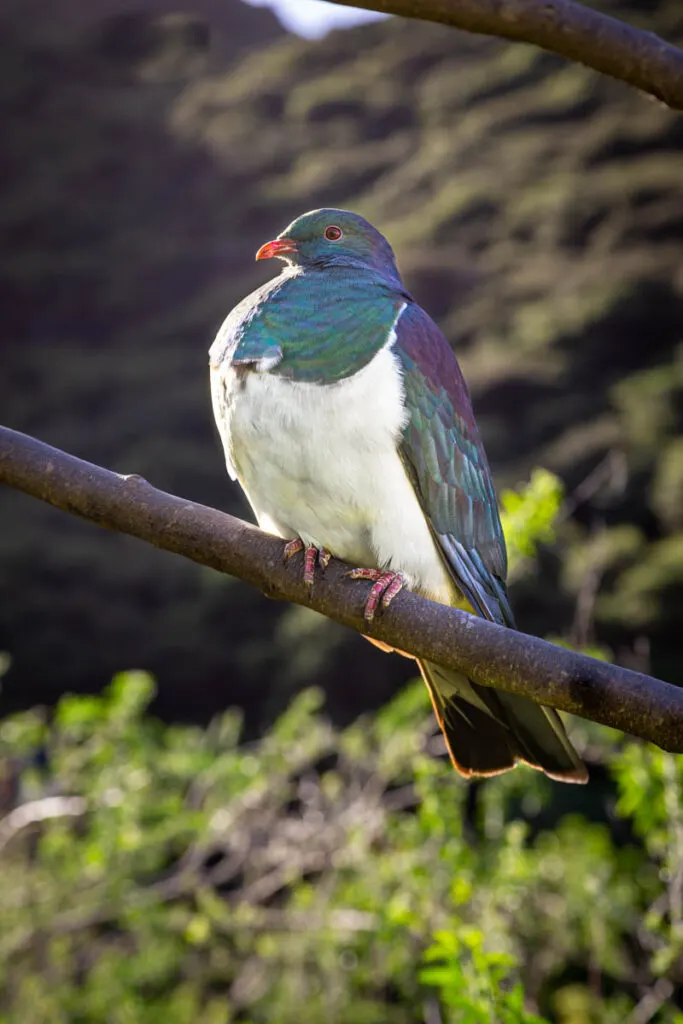
The 2 Pigeon Types
Although there are numerous ways of dividing up pigeons, we’ll examine the two categories most people use to differentiate the different types of pigeons, domestic and feral.
Domestic Pigeons
Common rock pigeons/doves (Columba livia) were first domesticated around 4500 BC.
Over thousands of years, humans selectively bred these pigeons for various purposes, creating the subspecies Columba livia domestica. These purposes include:
Utility pigeon breeds – humans bred these pigeons for meat production. Examples include King pigeons (the largest meat-production pigeons).
Fancy pigeon breeds – these pigeons are ornamental birds bred for their feathers and colors. They often compete in pageant-like competitions or are displayed at exhibitions. Examples include pouters, owls, fantails, fairy swallows, and tumblers.
Flier pigeon breeds – these pigeons excelled in their flying abilities and were used to carry messages. Homing pigeons and racing pigeons are classic flier pigeons, specially bred for their ability to return to their coop. They are powerful and well-muscled, making them perfect for flying races or delivering messages.
Pigeons are also regularly used as laboratory subjects (in recent years).
There are roughly 350 different types/varieties of domestic pigeons.
Feral Pigeons
There is a significant chance that the type of pigeon you saw in the park was a feral pigeon. These birds are also a subspecies of the rock pigeon (Columba livia).
However, they escaped captivity and infested parks, urban areas, and other areas.
Feral pigeons (Columba livia domestica) have slowly been replacing (through inbreeding) their wild ancestors across their natural range.
There are also wild pigeon types of different genera and species which occur globally.
For example, band-tailed pigeons are indigenous to the Americas and are not directly related (a different species) to feral and domestic pigeons.
22 Different Types of Pigeons
Here are some of the most fascinating types of pigeons found around the world. Let’s learn more about these beautiful birds.
1. New Zealand Pigeon
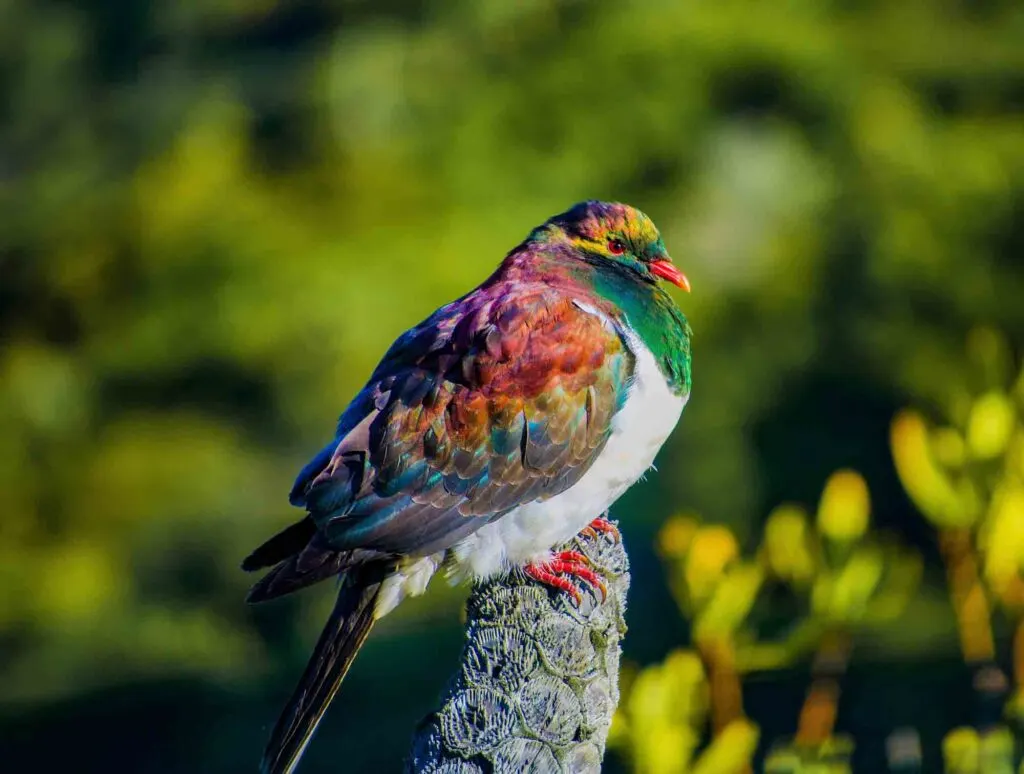
Also known as kereru (Hemiphaga novaeseelandiae), these types of pigeons are huge.
They grow up to 20 inches in length and 19–30 oz in weight, with white breasts and iridescent green–blue plumage.
The wings make heavy whooshing noises, making it impossible for this species to move around without alerting anyone.
Kererū pairs are monogamous, breeding over successive seasons and remaining together when not breeding.
2. Old Dutch Capuchine Pigeon
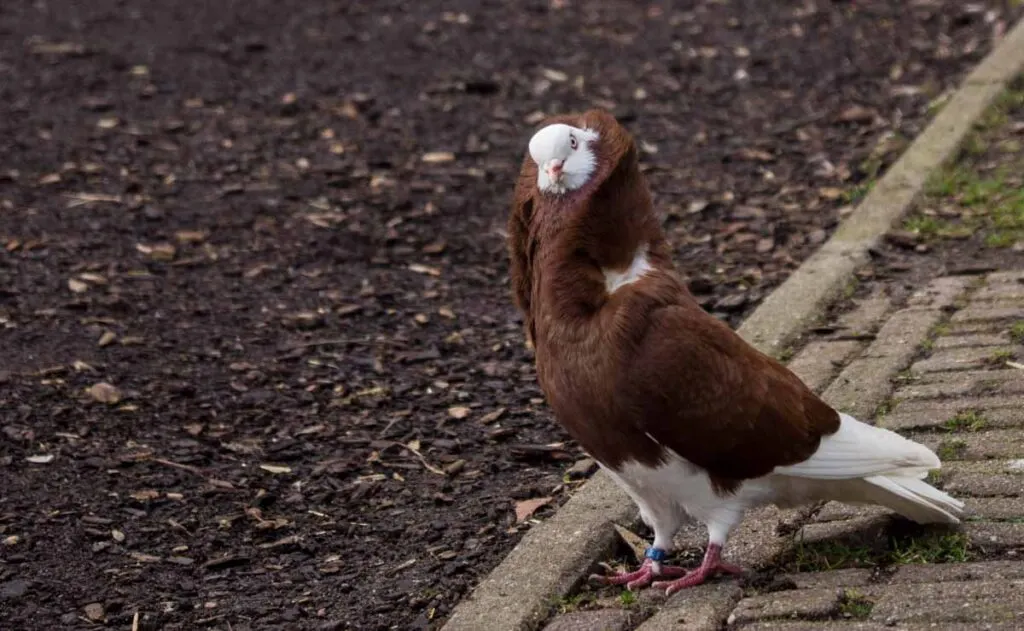
The most diagnostic feature of the old Dutch Capuchine pigeon (Columba livia domestica) is the collar-like feathers (hood) around its medium-length neck.
The hood resembles the cowls that capuchin monks wore as part of their robes. They have average-sized wings (23.62 to 27.56 in) and broad chests.
They are small to medium-sized (11.02 to 12.6 in. and weighing 10.93 to 13.05 oz) with a horizontal body, and their colors include black, blue with black bars, red, silver with dark dun bars, white self, cream with yellow bars, and yellow. Their legs are striking red.
These weird birds live between 6 and 15 years. Their diets are typically seeds, grains, berries, nuts, and fruit.
They are graceful birds with good temperaments that originated in the Netherlands.
Before its development in the Netherlands, these pigeons originated from Greece, India, or the Middle East.
Sailors probably imported these birds in the 16th century. These pigeons arrived in the US in 1960, mostly in urban and suburban environments.
They are ornamental/exhibition birds.
3. Nicobar Pigeon
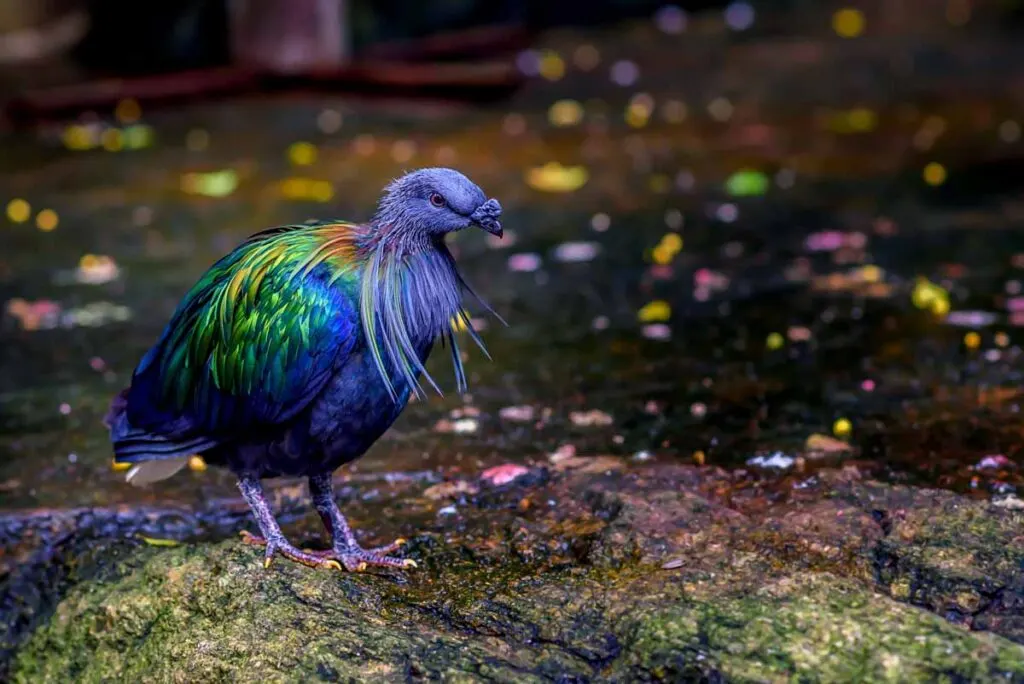
Nicobar pigeons (Caloenas nicobarica) are ground-dwelling pigeons that feature long plumes extending down from their necks.
While the appearance of their brilliant color largely depends on the light, they are mostly a mix of dark green, gray, blue, and bronze-like orange.
They have snow-white tails that stand out from their usual inclination toward dark tints.
Still, it is difficult to spot these colorful birds because they are quiet and shy.
These types of pigeons can be spotted on small islands and in coastal regions of the Andaman and Nicobar Islands in India.
Did you know? Dodo, an extinct bird species, was flightless and belonged to the Columbidae family.
4. African Green Pigeon
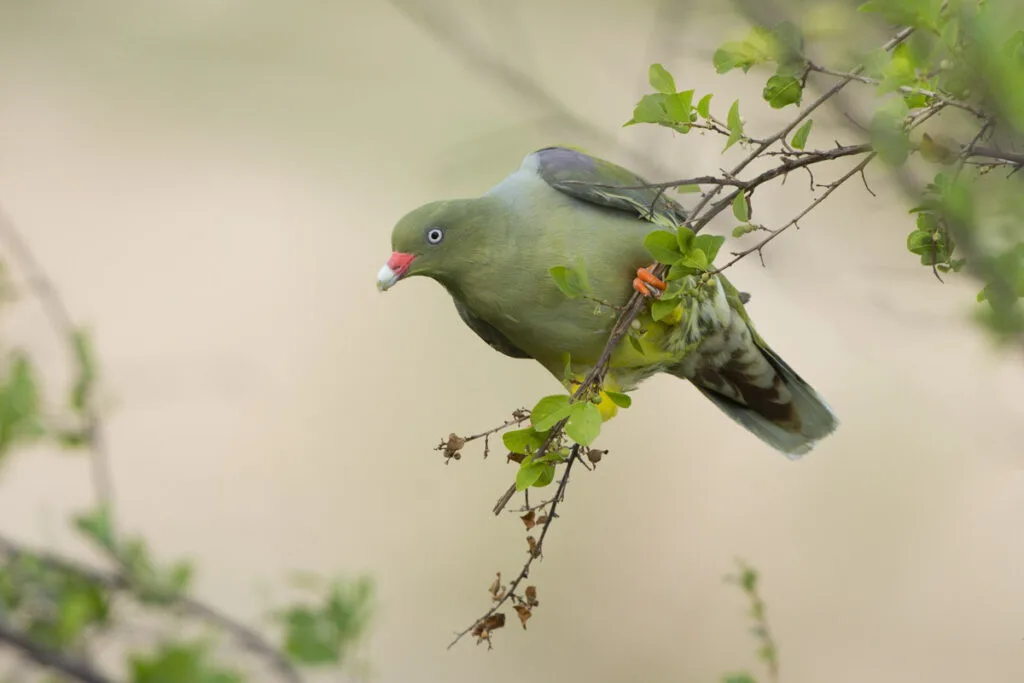
African green pigeons (Treron calvus) are gray-green to yellow-green on their upper parts, with burgundy shoulders and mauve patches on yellow things.
Overall, this breed of pigeons appears olive and grows between 8.5 and 11 in. They have white-tipped red bills and feet and weigh between 4.59 and 10 oz.
Widespread across sub-Saharan Africa, these pigeons are listed as Least Concern on the IUCN Red List.
Diet-wise, they are frugivores and predominately eat figs. However, they eat some seeds and (occasionally) small amounts of carrion.
African green pigeons are usually found in small groups. These pigeons forage in trees (hardly ever on the ground), occasionally hanging upside down. When they fly, it’s direct and quick.
Their preferred habitats are woodlands and forests (including closed evergreen, coastal dune forests, and mixed woodland). These pigeons are often food for eagles, falcons, and sparrowhawks.
Although boisterous and a bit clumsy, they remain well camouflaged and are similar in behavior to parrots. These are the most acrobatic of the pigeons, and they use their mobility to climb branches and reach fruit.
5. Band-Tailed Pigeon
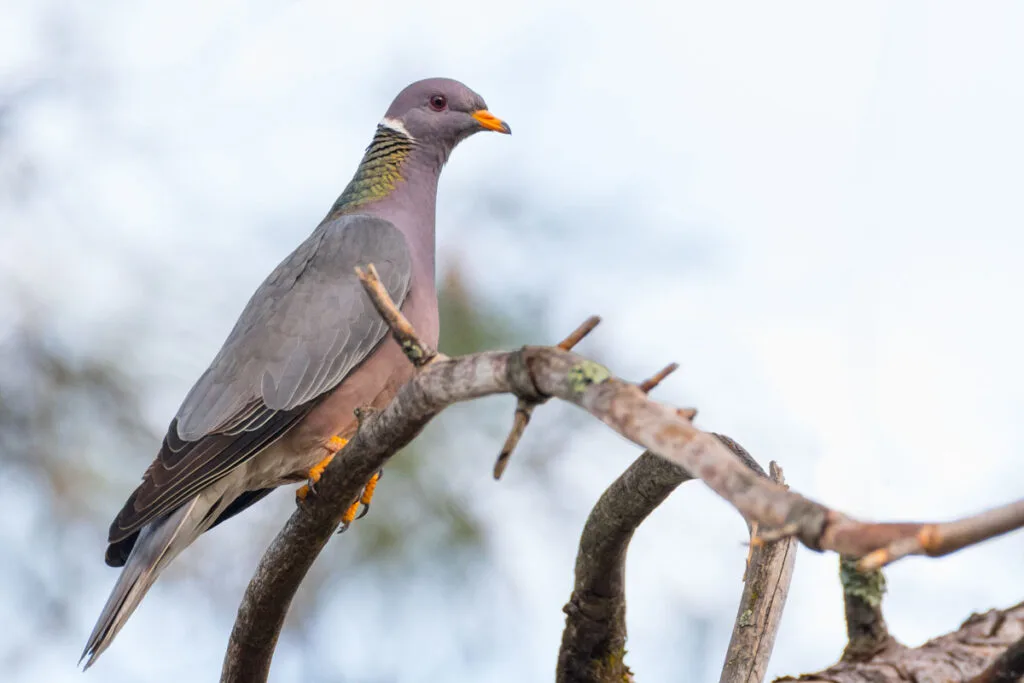
Banded-tailed pigeons (Patagioenas fasciata) have a distinct white crescent on their nape.
They are blue-gray on their upper parts, purple-gray underneath, and have pale gray wings with darker tips.
Also, this species of pigeon is between 13 and 16 in., weighs 7.9 to 18.2 oz, and has a wingspan of 26 in.
Their common name relates to the faded gray band at the tip of the tail, while the rest is a darker gray, and their feet and bill are yellow.
There are two populations of band-tailed pigeons. The first is found in North America, from southeastern Alaska to southern California. The second population lives in the dry mountain forests of Mexico, Central America, and northern Argentina in South America.
Also, they generally occupy woody habitats between sea level and 10,000 feet, including mountain forests (e.g., coniferous temperate rainforests and mixed), riverine areas, gardens, and parks.
In addition, these pigeons are gregarious (up to 300 birds), foraging on the ground and in trees for nuts (e.g., acorns), grain seeds, domestic and wild fruit (berries), leaves, and flowers.
This breed of pigeon is listed as Least Concern on the IUCN Red List. Still, its predators include Cooper’s and sharp-shinned hawks (gorgeous types of hawks), great horned owls (an imposing type of owl), peregrine and prairie falcons, and northern goshawks. Provided they are not eaten, they live up to 14 years.
6. Common Bronzewing Pigeon
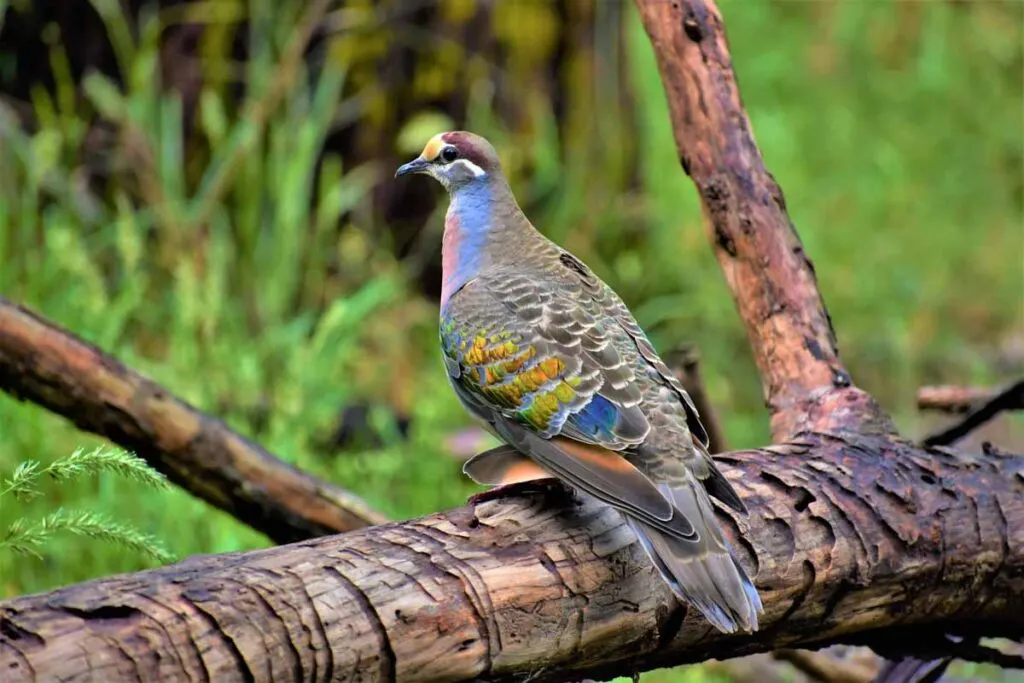
Common bronzewings (Phaps chalcoptera) are medium-sized pigeons (12 to 14 in.) with a heavy build (8.11 to 13.76 oz).
They have a white line below and around the eye, with patches of blue, green, and red (sort of metallic bronze) on the wing. They have black bills and purple-red feet.
Males have brown-pinkish breasts, yellow-white foreheads, and dark brown-olive upper parts. Their feathers have a characteristic “scaled” pattern. However, females are grayish with green.
Common bronzewings have a 19.69 to 22.83 in. wingspan and live to (roughly) 5 years.
Their vegetarian diet consists mainly of berries, grains, seeds, and occasionally invertebrates, and they are water dependent.
These intelligent birds inhabit cultivated lands, dry open woodlands, and shrubby savannahs (close to water) in Australia and Tasmania.
Although these pigeons are widespread and are listed as Least Concern, they are absent from dense forests and arid/desert areas.
These pigeon species cautiously fly straight and low to the ground. They are social birds, feeding on the ground in small groups, and when threatened, these pigeons crouch in the vegetation, attempting to hide before bursting out and flying off.
7. Carneau Pigeon
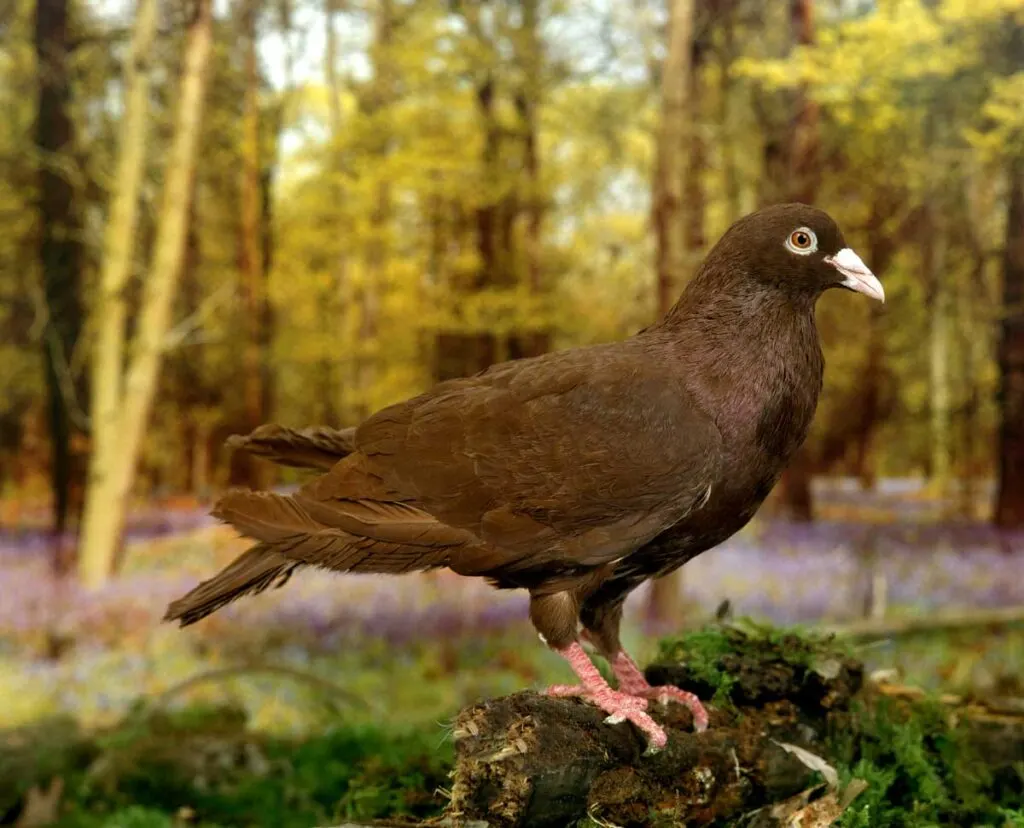
The Carneau pigeon (Columba livia domestica) usually has either white or red feathers. Their eye color depends on their feathers.
They look like well-proportioned rock pigeons (averaging 13 in.) with broad chests, round heads, and wedge-shaped tails.
The Carneau pigeon is a subspecies of the rock pigeon (Columba livia), developed through selective breeding in France and Belgium. Some sources suggest that the French Mondain pigeon was combined to create this breed.
There are some varieties in coloration and patterns. These pigeons live between 7 and 10 years, have wingspans of 31.5 to 35.43 in, and weigh around 34.12 oz. They are the second heaviest pigeon after the king pigeon.
They are social, interacting with humans and other birds. They have a charming demeanor. Carneau pigeons are usually in captive environments, urban areas, gardens, and parks.
Their diet is typically nuts, fruit, and berries. These pigeons are classified as domestic fancy types of pigeons, bred for exhibition and utility, specifically for their squab production (food) and large size.
8. Dragoon Pigeon
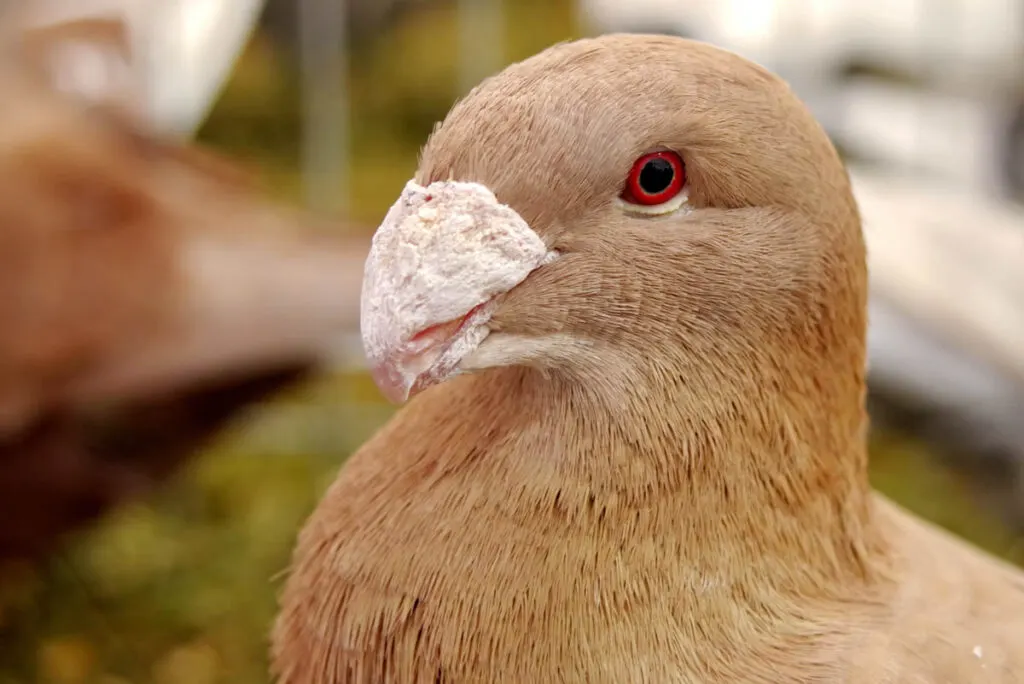
Another example of a domestic fancy breed (they are classified as homing and wattled pigeons and are an exhibition breed) is the dragoon pigeon (Columba livia domestica), which resembles a common rock pigeon.
They are medium-sized (approximately 15 in and up to 20 oz) with diagnostic short, thick necks and broad, wedge-shaped heads.
The name “dragoon” relates to their upright posture, similar to a mounted soldier of the same name.
Their beaks are short and blunt, and they have broad breasts. Dragoon pigeons’ colors vary but include a blue bar, blue check, dun, red, yellow, and white. Their wingspan is 25.2 to 28.35 in.
These pigeons originated in the United Kingdom in 1735; however, these wattled pigeons’ ancestry goes back to at least 1599, when they were used as carrier pigeons and were called “horsemen.”
This breed saw many changes, but finally, the British standardized the “London type” and the “Birmingham type,” with a preference for the London type dragoon.
These birds are alert and watchful. They are active and have friendly dispositions, making excellent pets. Interestingly, Darwin used the dragoon pigeon during his anatomical studies.
9. English Carrier Pigeon
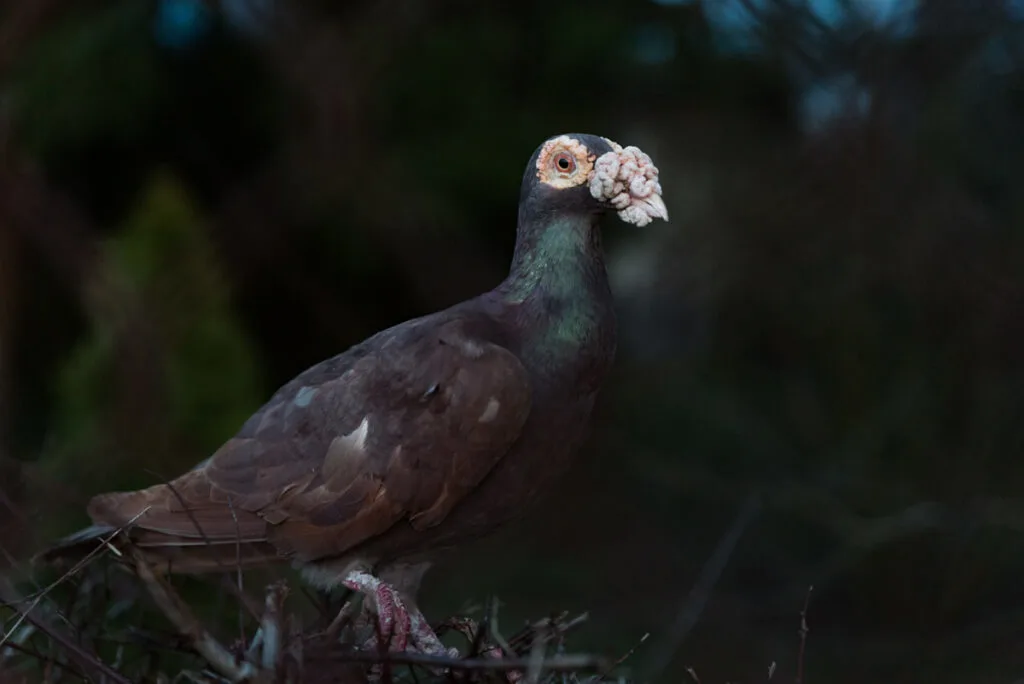
One of the carrier pigeon varieties, the English carrier pigeon (Columba livia domestica), is a type of fancy pigeon.
These large birds (weighing 17.64 oz) have long, slender bodies and necks (measuring between 17.32 and 18.5 in.). This pigeon is the largest of the carrier pigeon breeds.
They resemble rock pigeons in coloration, and common colors include black, blue-bar, dun, red, yellow, white, and pied.
Also, these pigeons have distinct wattles around their eyes and beaks (called box-beak). These strong fliers have 25 in wingspans.
This pigeon breed also originated in the United Kingdom, where the British bred these pigeons from various imported pigeons to carry messages. Breeders declared these pigeons at their optimal standard in the mid-1800s.
They live between 7 and 10 years. Calm and easily trained, they make great pets and exhibition birds. They mostly eat fruit, nuts, seeds, and berries.
10. Victoria Crowned Pigeon
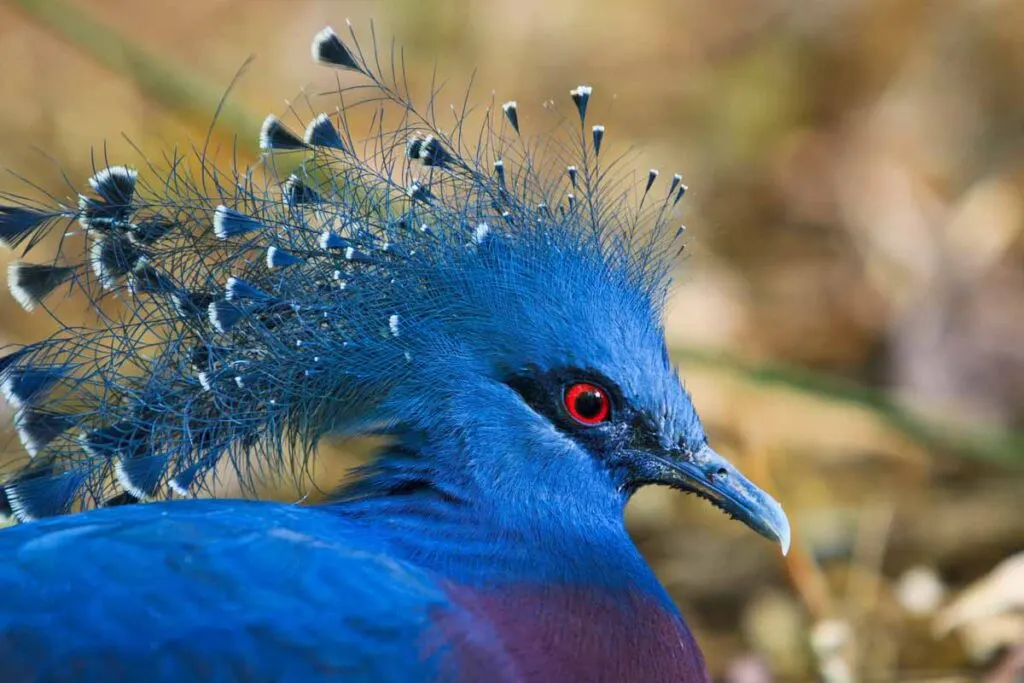
The largest pigeon breed in the world, Victoria crowned pigeons (Goura victoria) have a unique crest of feathers on their head.
They grow up to 31 inches and weigh almost 7.7 pounds.
With beautiful blueish-gray feathers over their bodies and maroon chest, they are easily one of the prettiest pigeon species.
The diet of these pigeons includes seeds, berries, and fruits, and they have no natural predators in their natural habitat.
Further out, these types of pigeons are native to New Guinea.
11. English Trumpeter Pigeon
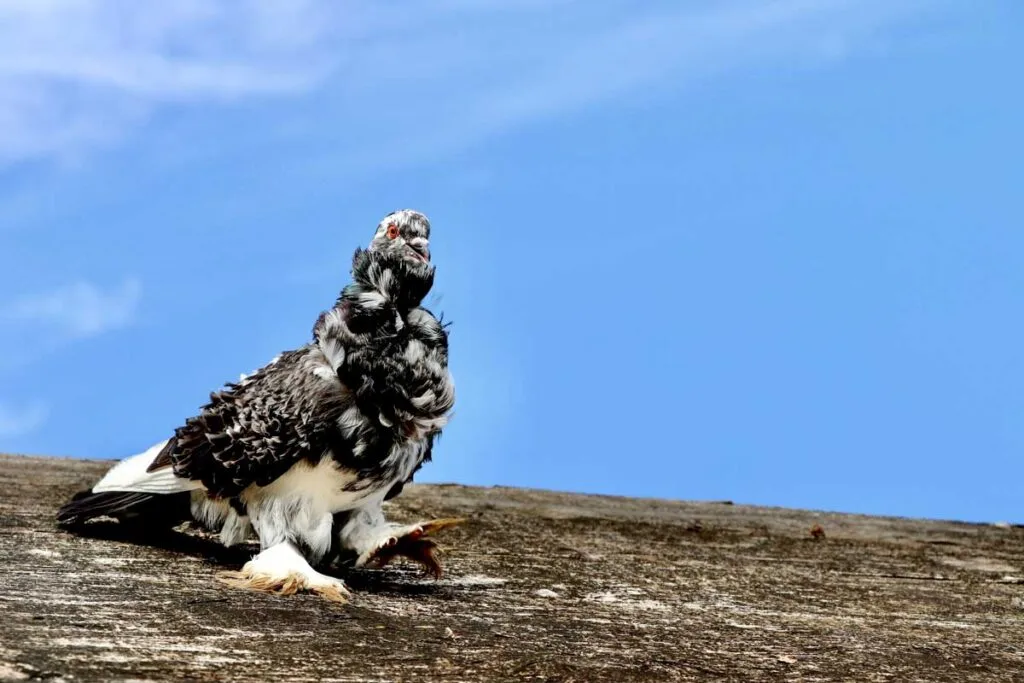
The English trumpeter pigeon (Columba livia domestica) is another domestic fancy type of pigeon (an ornamental breed).
They are small to medium pigeons (roughly 11.02 in and weighing 13.05 oz) with a distinct cape-like crest, swept backward, exposing the face.
Diagnostic of this species are the leg feathers which continue to long “muffs” on their feet (sometimes as long as the flight feathers). Their colors include baldhead, self, and splash (black and white or yellow).
Developed in the UK and the US, these captive pigeons live between 5 and 7 years.
Often seen in parks, pastures, or around homes, they have gentle natures, making fantastic pets. However, they might be shy and lazy and do not fly well.
The mention of “trumpeter” pigeons dates back to the 17th century, and although the breed originated in the UK, the modern iteration is from the US and is one of the most popular breeds.
As their common name implies, these pigeons make a trumpeting sound.
12. Fantail Pigeon
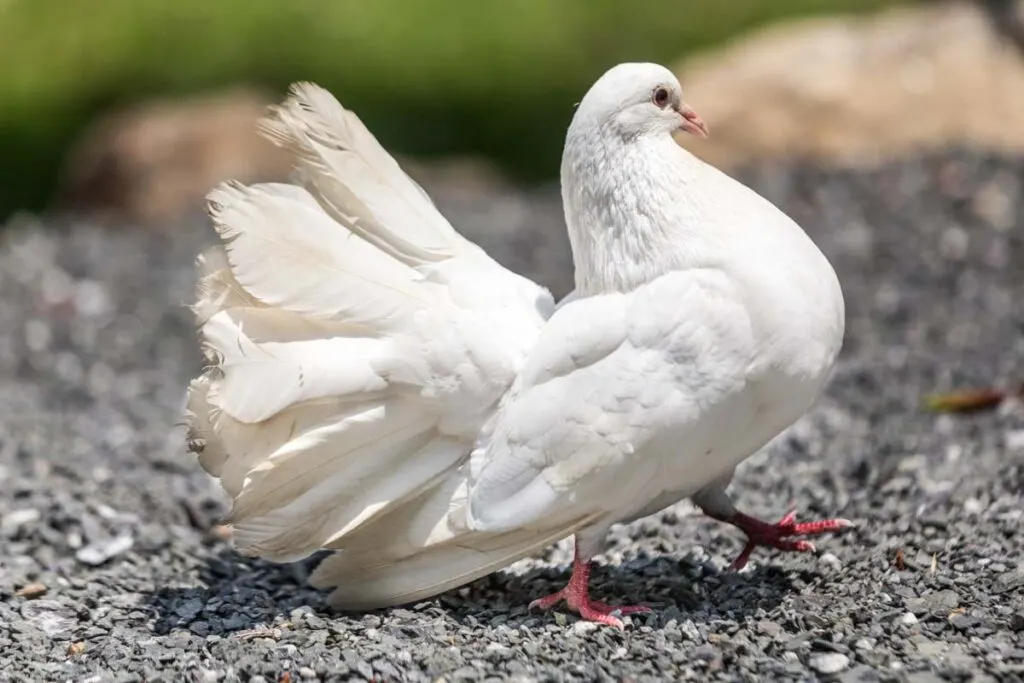
Fantail pigeons (Columba livia domestica) are domestic fancy pigeons. These types of pigeons have 30 to 40 tail feathers arranged in a “fan” (like a turkey’s tail).
Most others only have 12 to 14 tail feathers. Their wingspan is between 25.2 and 28.35 in.
These medium-sized pigeons (9.5 to 15 in and 8.82 to 21.16 oz) come in various colors (and sizes), including black, blue, dun, red, silver, white, yellow, and mottled/splash.
Living up to 15 years, these pigeons eat “pigeon mix” with grains, seeds, fruit, vegetables, and berries. These birds are poor fliers and don’t raise their chicks well.
This fancy breed was possibly developed in China, India, Pakistan, or Spain as exhibition pigeons or pets.
Although there are seven subvarieties, the most popular are the Indian fantail, English fantail, and Thai fantail.
Silkies’ (Indian or American fantails) tail feathers appear lacey due to genetic mutations.
These pigeons were also part of Darwin’s experiments/studies.
13. Frillback Pigeon
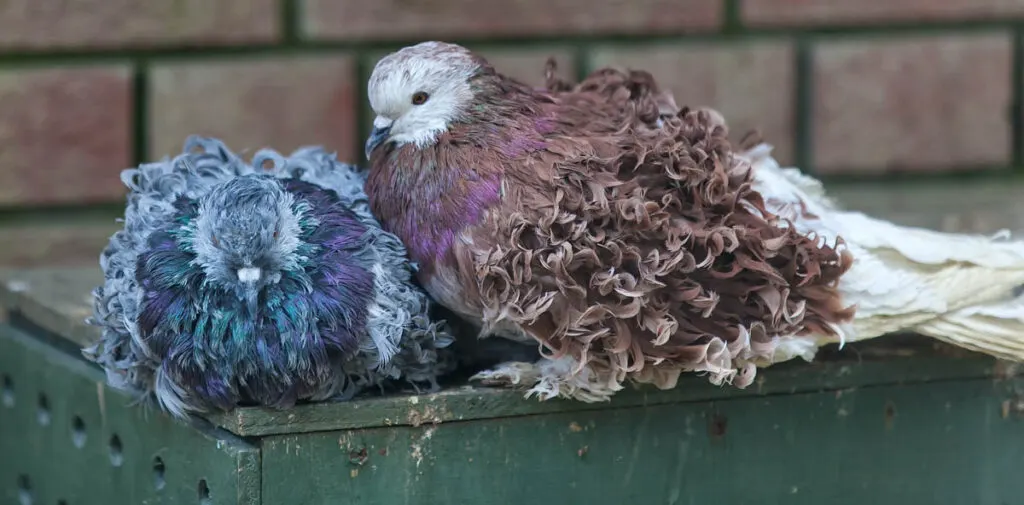
Frillback pigeons (Columba livia domestica) are another domestic fancy type of pigeon.
Their curly feathers (the reason for their common name) are diagnostic and occur on their wing shield feathers and feet feathers (muffs).
They are medium-sized (approximately 20 in. and 20 oz) types of pigeons that come in many color variations, including blue, red, silver, yellow, rose-wing, and other patterns, self, and shield-marked. Their beak color changes with feather color.
These mostly calm pigeons make great pets that live between 5 and 10 years. Although they can fly, they prefer walking.
Their diet consists of mixed fruit, nuts, berries, greens, and other “pigeon mixes” when in captivity. These pigeons are also for exhibition and ornamental purposes.
Frillback pigeons originated in Asia Minor, and scientists believe that curly feathers result from genetic mutations in 2 or 3 genes.
14. German Modena Pigeon
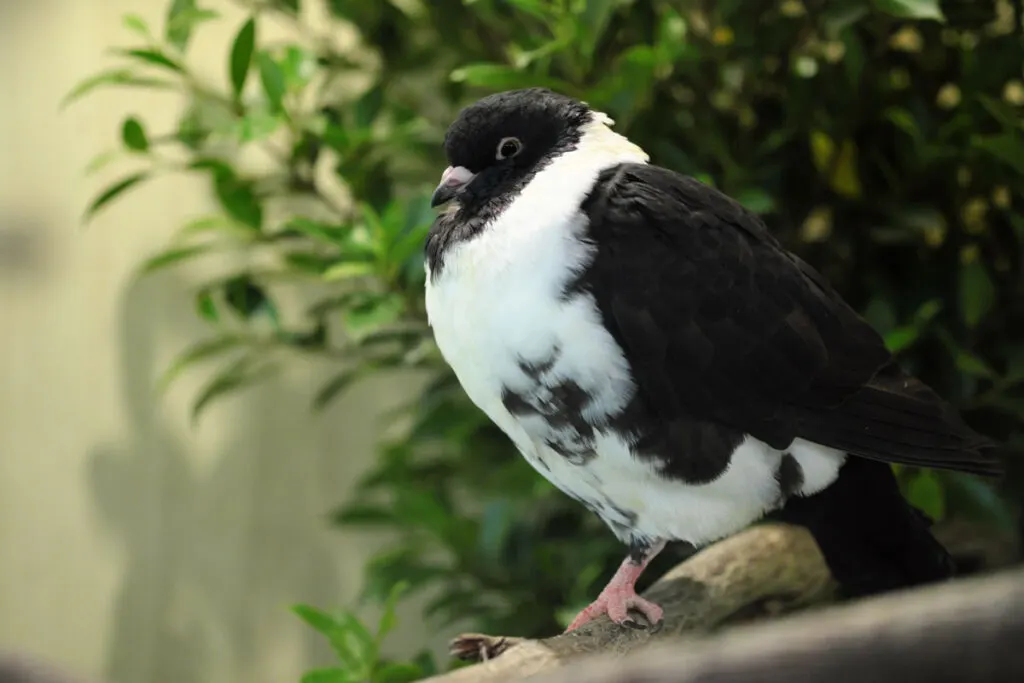
The German Modena pigeon (Columba livia domestica) is an unusual-looking domestic fancy pigeon.
These pigeons have an almost chicken-like look to them. They have long legs and necks, broad, rounded bodies, and slightly upturned tails. They reach roughly 7 in. and weigh around 12.35 oz.
They have short wattles on medium beaks and red-orange eyes. These pigeons come in various colors and patterns, including black, blue, red, white, yellow, or a combination (pied, bars, splats, etc.). Their wingspan is between 25.2 to 28.35 in.
The origins of this pigeon date back to 16th century Germany and Italy, and many believe they originated from crossing the Spanish trumpeter with the Italian pigeon.
They are easy-going, good temperament birds that are well-behaved, most often found in urban and suburban areas, gardens, and parks.
These pigeons are the smallest breeds of the “hen/chicken pigeon.”
Utility breed pigeons are often raised as ornamental/exhibition birds or pets. They are also farmed for meat in some countries.
The “Modena” part of their name comes from the town in Italy where these pigeons were first bred around 1300.
15. German Nun Pigeon
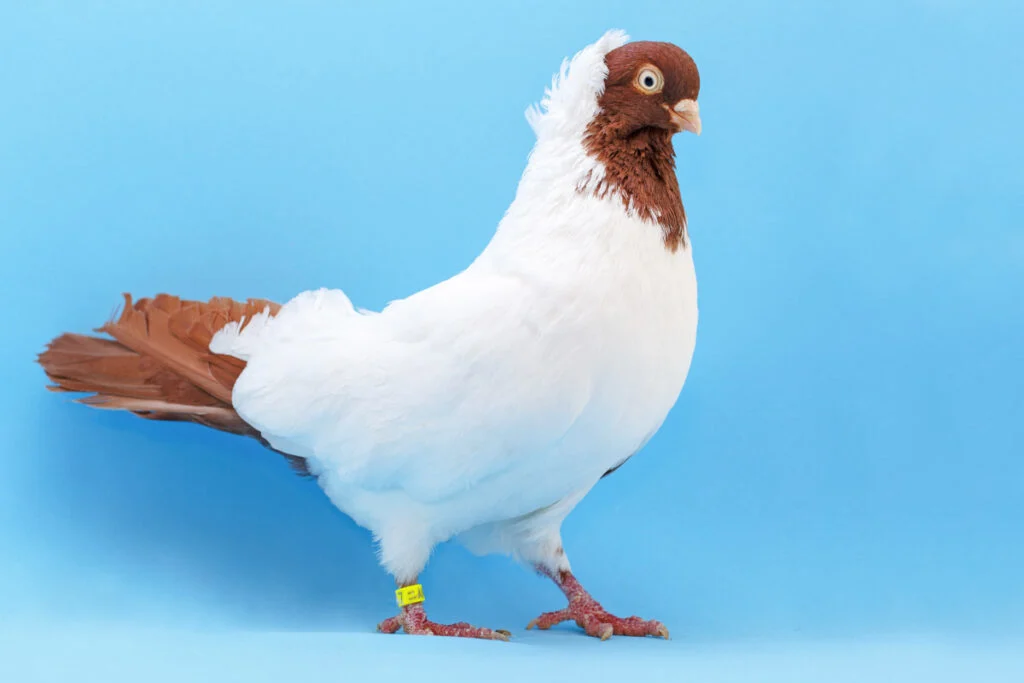
The German nun pigeon (Columba livia domestica) is a domestic fancy pigeon breed.
These medium-sized pigeons (roughly 10 in. And 12.64 oz) are predominantly white with a colored head, tail, and wingtips. Their posture is considered “perfect,” and they have broad chests.
Colors include ash-gray, coffee-brown, black, light blue, red, silver, and yellow. German nun pigeons have short bills and crests on the back of their heads.
The name “nun” refers to the cap pattern on their head, and they have a cross pattern on their wings (visible during flight).
They live to around six years and eat seeds, nuts, fruit, etc.
Originating in Germany in the 1600s, these types of pigeons are excellent fliers with calm dispositions, usually found in urban areas like parks or residences.
These pigeons are also classified as “tumblers,” bred for exhibitions and flying. Their flight is a short, low, circular soar.
16. Lahore Pigeon
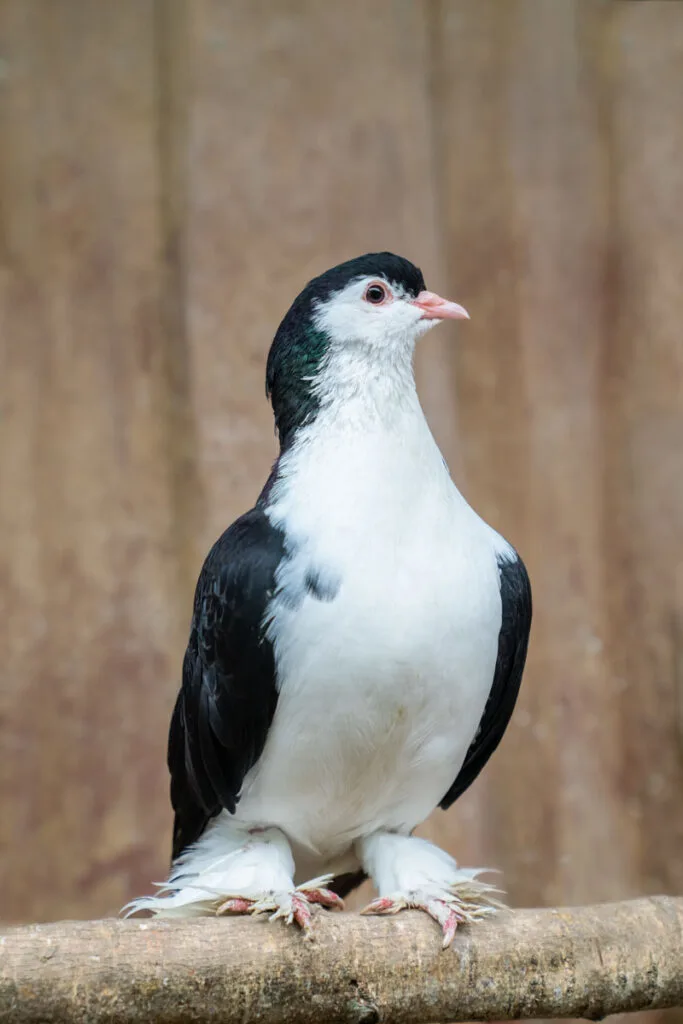
The Lahore pigeon (Columba livia domestica) is a type of domestic fancy pigeon. They are large birds with a horizontal body stance with broad shoulders and breasts.
They grow to around 11.5 in and weigh between 17 and 18 oz, with wingspans between 25.2 and 28.35 in.
While their tails and rumps are white, their upper parts vary. Common colors include checkered, black, blue, blue-bar, brown, and red. They have thick/dense feathers on their necks and legs.
This pigeon breed originates from Lahore, Pakistan, and they have a calm, gentle, and shy nature. They are strong and hardy birds, mainly found in urban areas like parks/residences.
Pigeon enthusiasts/breeders imported these pigeons to Germany in 1880, and their popularity increased during the 1960s.
Breeders believe that these pigeons originated from Persia, where they were bred for meat; however, they are more of an ornamental and pet bird in modern times.
17. Zoe’s Imperial Pigeon
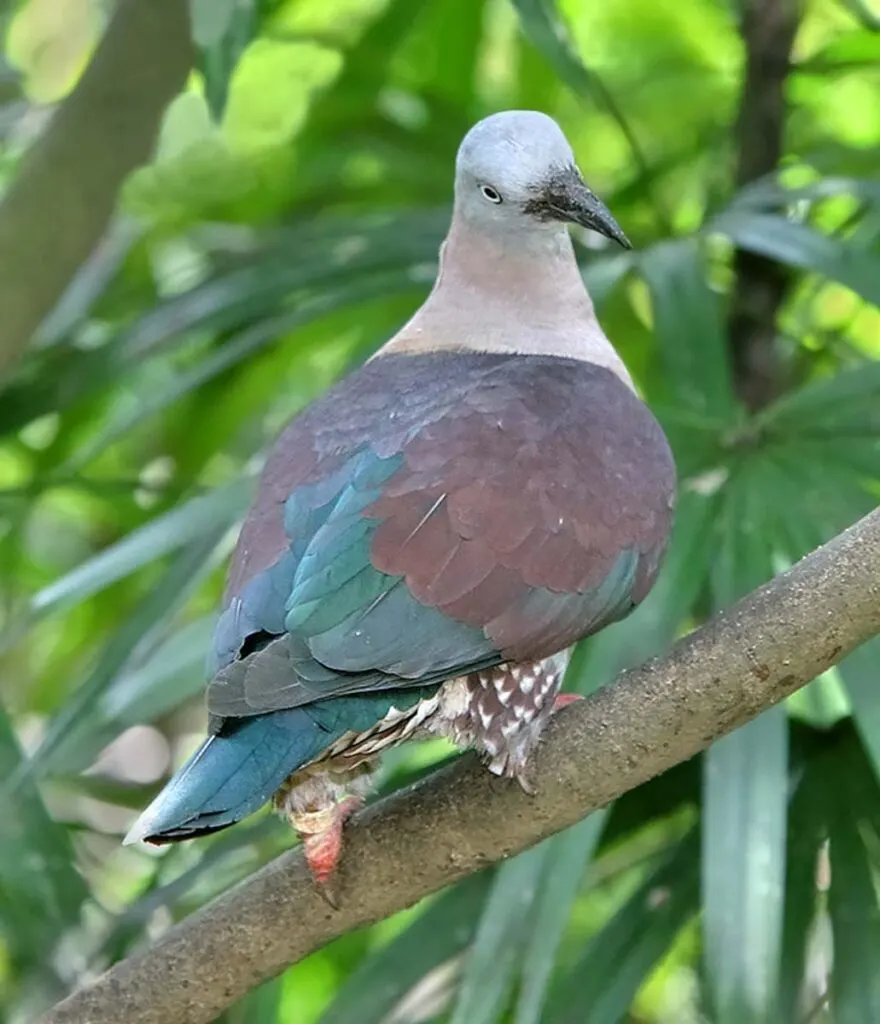
Zoe’s imperial pigeons, also known as the banded imperial pigeons, are a species of the Columbidae bird family.
They are found in New Guinea, and their natural habitats are subtropical or tropical moist lowland forests, mangrove forests, and montane forests.
These animals that start with Z are named after Zoë Lesson, the wife of French ornithologist René-Primevère Lesson, who described them.
18. Pied Imperial Pigeon
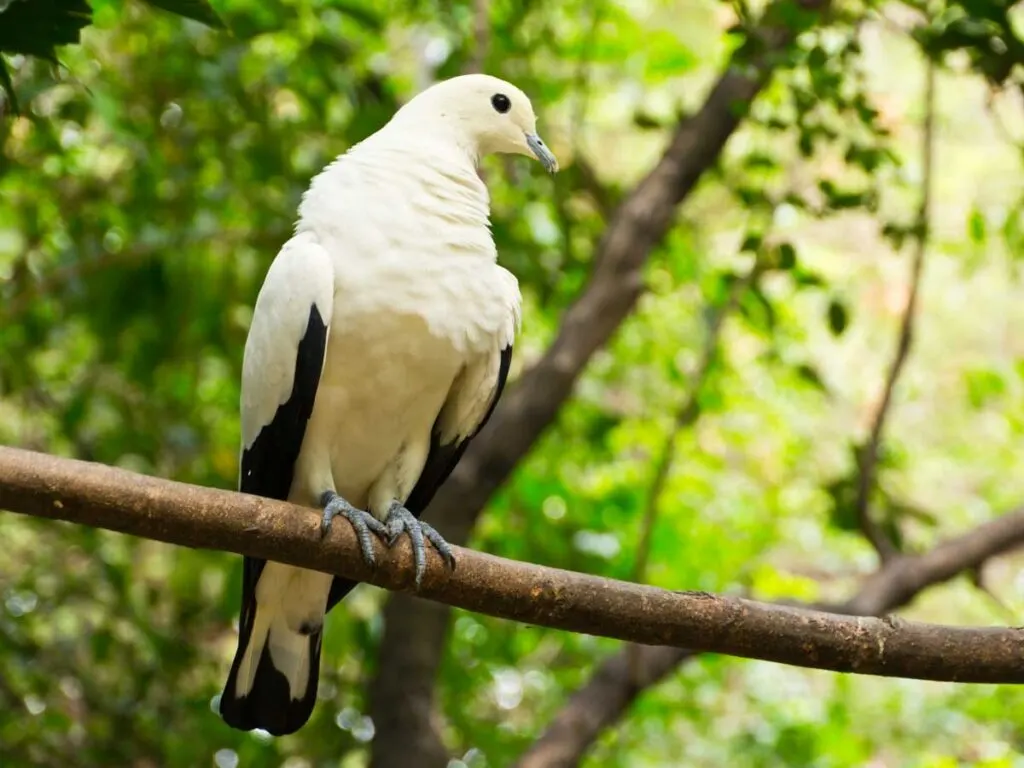
Pied imperial pigeons (Ducula bicolor) are large white-yellow pigeons with black primaries, secondaries, and tail tips (trimming).
They grow to 14.75 in and weigh between 12.88 and 17.99 oz, with wingspans of 17.72 in.
Although these birds live up to 8 years in captivity, the average is four years. Their diet consists primarily of fruit, but they’ll consume grains and seeds too. They are listed as “least concern.”
These pigeons occur in Southeast Asia, Indonesia, the Philippines, and New Guinea, where they inhabit coastal forests, woodlands, and plantations on islands.
They leave the small islands to forage on the mainland. They perch high in trees or telephone lines (up to 200 feet).
They are social, in flocks of 10 birds. Although they don’t migrate, flocks follow fruiting trees throughout the year. They often make long flights over the ocean/seas for forage.
An interesting feature of pied imperial pigeons is that their jaws stretch with elastic sockets to accommodate the large nuts this pigeon eats (e.g., nutmeg).
19. Pink-Necked Green Pigeon
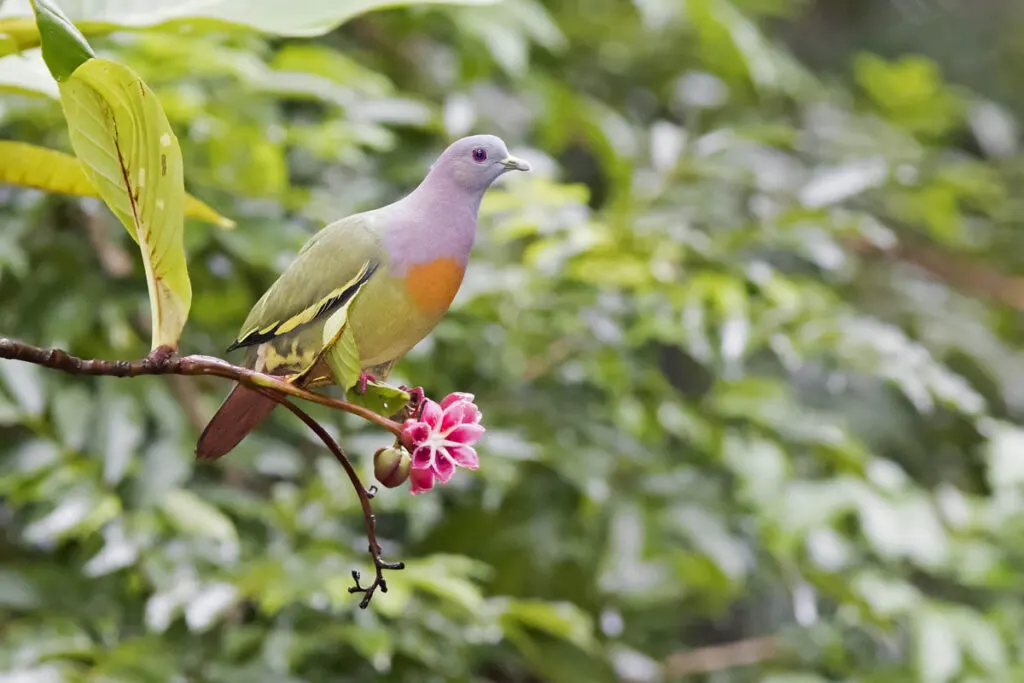
The medium-sized (9.84 to 11.81 in and 3.7 to 5.64 oz) pink-necked green pigeon (Treron vernans), so named because of the male’s pink neck, is mostly green with an orange patch on their breasts, a yellow belly, and a gray-blue head.
Their wing feathers are black and yellow, and their tails have a light blue patch with yellow spots underneath. Their wingspan is 11.81 in, and they live for five years.
They are tree-dwelling, gregarious pigeons, mixing with other green pigeon types.
Pink-necked green pigeons are relatively quiet for pigeons and are obligatory frugivores; however, they occasionally eat seeds and buds.
They feed from the mid-canopy and infrequently/rarely from the understory and ground.
Pink-necked green pigeons occur in Southeast Asia, including Myanmar, Vietnam, Indonesia, and the Philippines, where they inhabit mostly lowland areas, mangroves, open coastal forests, parks, gardens, and plantation edges. They are listed as “least concern.”
Several pigeons in the Treron genus do not have cooing calls. Instead, they make whistling and quacking noises (with some cooing in this species).
20. Pomeranian Pouter Pigeon
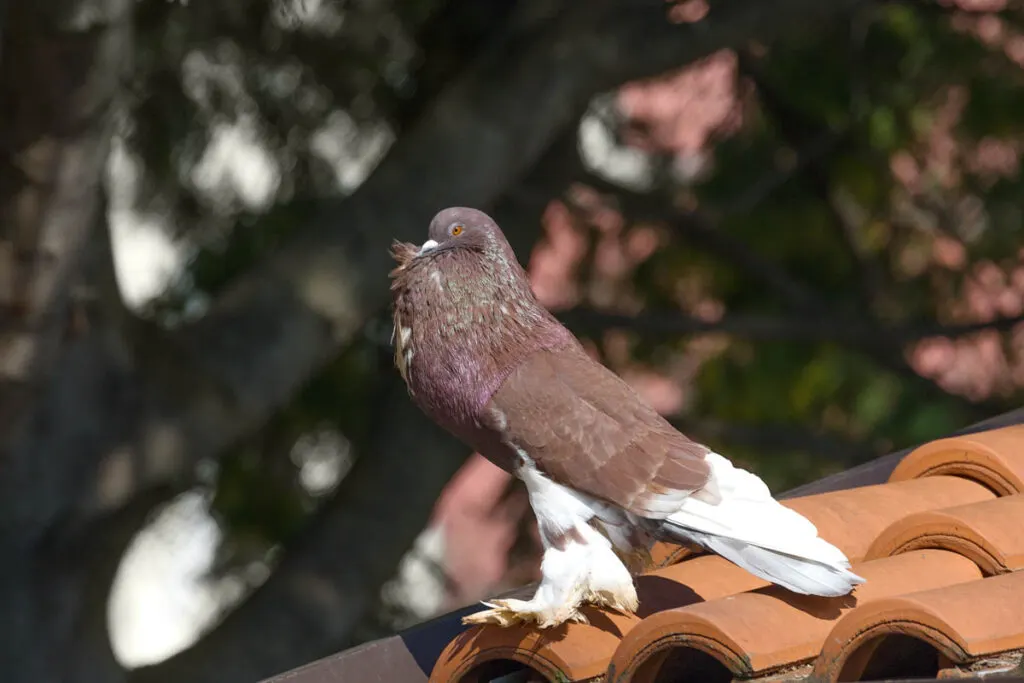
The Pomeranian pouter pigeon (Columba livia domestica) is a type of domestic fancy pigeon.
Their common name derives from their “inflatable” crops. They have long legs (and necks) and an upright body position (between 60 and 80 degrees).
Pomeranian pouter pigeons grow between 20 and 24 in, weigh between 22 and 30 oz, and live between 7 and 10 years.
Their colors include black, blue, brown, checks, khaki, red, silver, yellow, and white-self, with various markings. They have feathered legs and large muffs.
These pigeons originate from Pomerania in Germany; most are in captive, urban, or suburban environments.
They are ornamental birds or pets with a calm nature and are an offshoot from the Dutch and (potentially) English pouters/croppers.
21. Saxon Fairy Swallow Pigeon
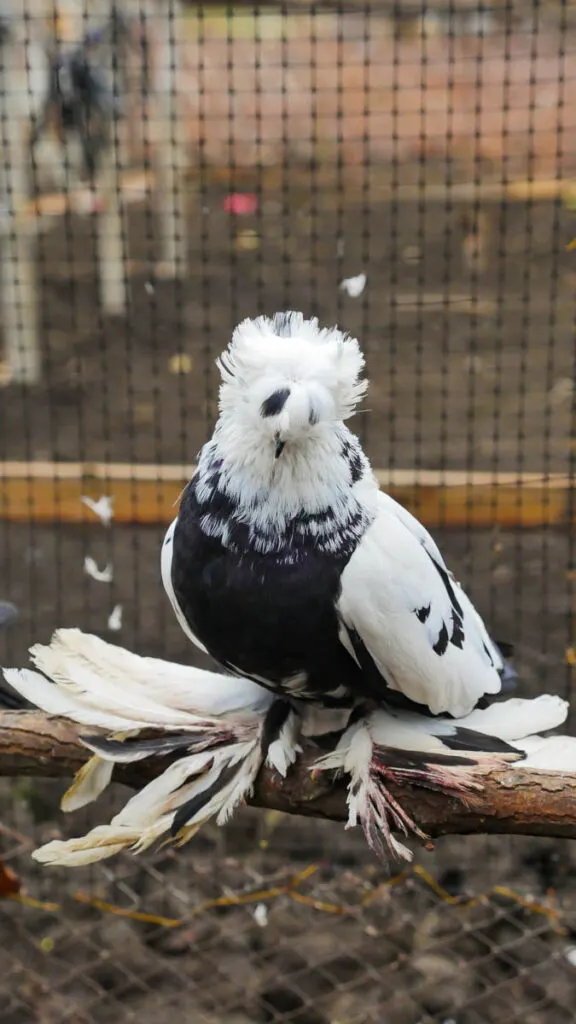
The Saxon fairy swallow pigeon (Columba livia domestica) is a domestic fancy breed. They are also called the Bohemian fairy swallow pigeon.
These small to medium pigeons (roughly 14.75 in and between 12.7 and 13.4 oz) have heavily muffed feet (a diagnostic characteristic).
They range in colors and marking/patterns, including spot and cap markings. Colors include black, blue, red, silver, yellow, and white barred and laced.
These pigeons have neck crests; although they may live up to 15 years, they average between 5 and 6.
These calm, gentle birds are average fliers from Saxony (Germany). They are most often in urban and suburban areas. They are generally exhibition/ornamental birds and pets.
Saxon fairy swallow pigeons arrived in the US in 1868.
22. Wood Pigeon
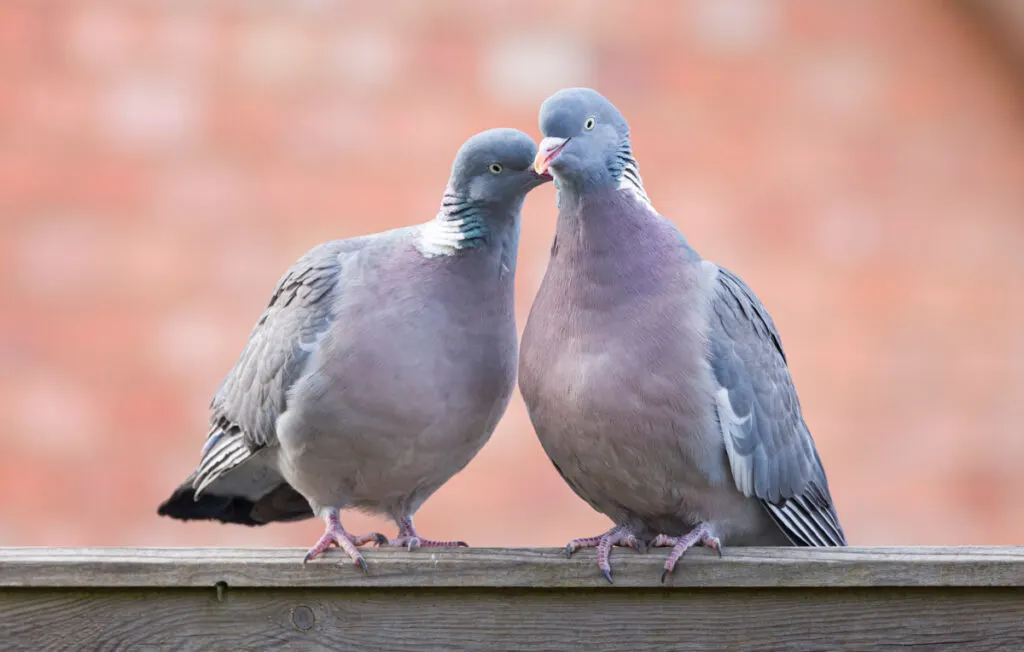
The common wood pigeon (Columba palumbus) is a large (between 15.75 and 16.54 in and weighing 16.93 to 19.4 oz), heavy-set bird, mostly gray with a white/pale nape patch (some populations have a tan neck patch).
Their wingspan is 29.53 to 31.5 in, and they have white bands on their wings (visible in flight). Their broad tails are black-tipped.
Although they might live up to 17 years, they average at around 3.
They follow a typical pigeon diet of Nuts, seeds, berries, shoots, and crops. These gregarious birds are clumsy and noisy, often crashing through bushes/hedges; however, they are listed as “least concern” and are widespread.
They mostly inhabit wooded, semi-open, urban, and suburban areas across Europe, the UK, Russia, the Middle East, Central Asia, North Africa, and surrounding islands, including Iceland. They are the UK’s most common and largest pigeons.
Although they are shy in rural areas, they quickly become habituated/tame in urban environments.
Other Different Types of Pigeons Worth Knowing
Ice pigeons – gorgeous white pigeons with unfeathered legs or with muffed pompous legs.
Mourning dove – also known as turtle dove, this beautiful bird is widespread in North America.
Archangel pigeon – this fancy pigeon breed has an iridescent metallic sheen on its body.
Helmet pigeons – Helmets, along with other varieties of domesticated pigeons, are all descendants of the rock pigeon.
That’s it for today. If you know more varieties of pigeons that should be on this list, feel free to let us know in the comment section below. We’d love to hear from you!
